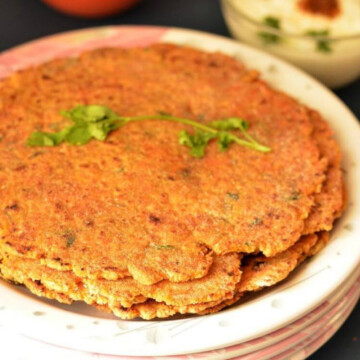
Rajgira Thepla Recipe
Rajgira Thepla is a nutritious Indian flatbread made from amaranth flour (rajgira), yogurt, and spices like cumin and turmeric. Rolled thin and cooked on a skillet, it's gluten-free and rich in protein and fiber. Often enjoyed with yogurt or chutney, it's a healthy option for snacks or fasting days.
Ingredients
Ingredients:
- 1 Cup Rajgira flour (Amaranth flour)
- 1 Medium potato, boiled and mashed
- 1 teaspoon Green chili paste (or finely chopped green chilies)
- 1 tablespoon Fresh coriander, chopped
- ½ teaspoon Cumin seeds
- ¼ teaspoon Ajwain (carom seeds)
- ½ teaspoon Red chili powder
- ½ teaspoon Rock salt (sendha namak) or as per taste (for fasting)
- 1 tablespoon Yogurt (optional, skip for vegan version)
- 1 tablespoon Ghee (for non-fasting days, use oil for fasting)
- Water, as needed
- Ghee or oil for cooking the theplas
Instructions
Making the Dough
- To start, take a bowl and add the rajgira flour.
- Then, add the mashed potato, cumin seeds, red chili powder, turmeric powder, and salt.
- Mix these ingredients well. If you are using yogurt, add it now to make the dough softer.
- Next, gradually add a little water to the mixture and knead it into a soft dough. Make sure not to make it too sticky; a little oil on your hands can help.
Rolling the Theplas
- Once the dough is ready, let it rest for about 10-15 minutes. This resting time helps the dough become softer and easier to handle, making it much more manageable when you roll it out.
- After resting, divide the dough into small balls.
- Now, take one ball and flatten it slightly. Dust it with a little rajgira flour and roll it out into a circle.
- Make sure the thepla is not too thick; it should be about the thickness of a regular chapati. If it cracks at the edges, that’s okay—just press it gently with your fingers.
Cooking Techniques
- Now, it's time to cook! First, heat a skillet or tawa over medium heat. This ensures the thepla cooks evenly and gets nice and crispy.
- Once the skillet is hot, next, add a little oil or ghee. Then, place the rolled-out thepla onto the skillet and let it cook.
- Cook it for about a minute until you see bubbles forming on the surface.
- Then, flip it over and add a little more oil or ghee on the top side.
- Cook until both sides are golden brown and crispy. This will take about 2-3 minutes. Keep an eye on them so they don’t burn!
Notes
Variations
-
- Stuffed Rajgira Thepla: Want to try something different? I once stuffed my Rajgira Thepla with mashed potatoes and spiced veggies, and it turned out amazing! It made the thepla even more filling, and everyone at home loved it. You could also try adding paneer for a cheesy twist!
-
- Different Spice Blends: If you like experimenting, add a pinch of dried fenugreek leaves (methi), black pepper, or even a little cinnamon and nutmeg! I remember my cousin adding methi once, and it made the flavor so rich and aromatic—totally changed the game!
-
- Vegan and Dairy-Free Options: For a vegan version, I swapped out ghee with coconut oil and used almond yogurt instead. It tasted just as good, and I didn’t miss the dairy at all! Try it out, and you might just love it!
Storage and Make-Ahead Tips
1. Storing Thepla: If you have leftovers, simply store the Rajgira Thepla in an airtight container for up to 2-3 days. One time, I made extra theplas for a family trip and stored them in a container, and they stayed fresh and tasty! You can also freeze them for longer storage. Just wrap them well, and they’ll be good for up to a month! 2. Reheating Thepla: To bring back that crispy texture, reheat the thepla on a griddle or tawa. I remember once reheating a leftover thepla on the griddle, and it was just like fresh—crispy on the outside, soft inside! 3. Meal Prep Ideas: Rajgira Thepla is perfect for meal prepping! You can make a big batch at the start of the week, store it in the fridge, and have easy meals ready for busy days or fasting periods. I do this all the time when I know my week is packed with school and activities. It saves so much time!Nutrition
Nutrition Facts
Rajgira Thepla Recipe
Amount per Serving
Calories
180
% Daily Value*
Fat
7.5
g
12
%
Saturated Fat
2.5
g
16
%
Polyunsaturated Fat
1.25
g
Monounsaturated Fat
3.75
g
Cholesterol
3.75
mg
1
%
Sodium
125
mg
5
%
Potassium
200
mg
6
%
Carbohydrates
30
g
10
%
Fiber
4
g
17
%
Sugar
0.75
g
1
%
Protein
5
g
10
%
Vitamin A
125
IU
3
%
Vitamin B1
0.075
mg
5
%
Vitamin B2
0.05
mg
3
%
Vitamin B3
0.5
mg
3
%
Vitamin B5
0.125
mg
1
%
Vitamin B6
0.1
mg
5
%
Vitamin C
2.5
mg
3
%
Vitamin E
0.25
mg
2
%
Vitamin K
1.25
µg
1
%
Calcium
25
mg
3
%
Iron
1
mg
6
%
* Percent Daily Values are based on a 2000 calorie diet.
Tried this recipe?Let us know how it was!